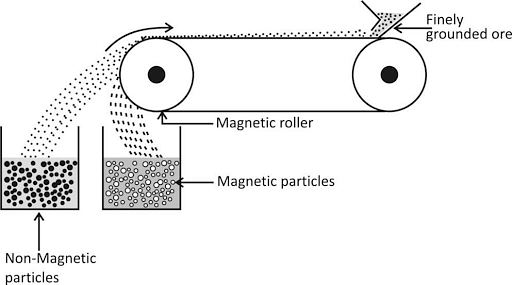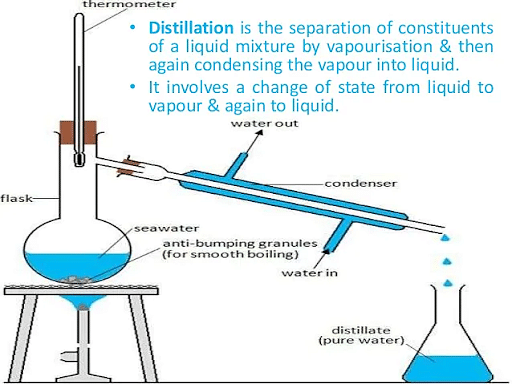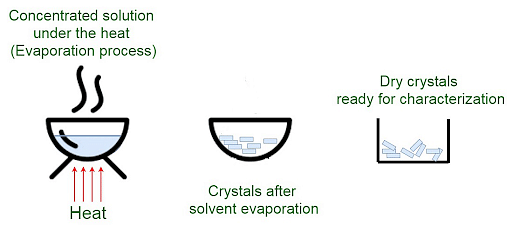
Content Curator
We do always see our mother separating stones or other substances from wheat, rice, or dal by washing them. Most of the substances we use in our daily life are not present in their pure form. We are supposed to separate useful components of the mixtures by using various ways of separation. In this article, we will discuss the need to separate substances, different methods of separation, etc.
| Table of Content |
What is Separation?
Separation is a method of separating a mixture into its components. The method is used in our daily life as well as at a commercial level.
Separation can be performed on a small scale such as in a laboratory and also on a large scale such as in a chemical Plant.
Read Also: Saturated Solution
Methods of Separation Under Dry Condition
Handpicking
This method of separation includes just picking out the substances and separating them from the other substances. When we buy rice or wheat from a grocery shop and spread it on the plate or paper, what do we see? We do not find only rice or wheat on the sheet or plate, there are pieces of husks, stone, broken grains, and particles of any other grains in it. What do we do? We remove those particles with our hands. This method is termed as Handpicking.

Threshing
Threshing is mostly used during crop harvesting. It is usually used by farmers on their farms during the harvesting process. During the harvesting of wheat, the stalks of wheat are dried. After this step, each grain is separated from the stalks. In this method, the dry stalks are beaten and shaken off from the dried grains. Threshing can be performed either by cattle, hand or by using machines.

Winnowing
After threshing the wheat, the grains are cleared and cleaned of the chaff and husk before grinding it into flour. The husk and chaff are separated from the wheat in this method.
In winnowing, the farmer is supposed to gently drop the mixture to the ground from a certain height. The heavier grains are collected at a place, whereas the chaff which is lighter blows away.

Sieving
Sieving is used to separate substances of different sizes. In this, the sieve is used for separation. The smaller particles of the mixture pass through the sieve’s pores but the bigger ones are retained.

Magnetic Separation
Magnetic Separation is used to separate the components that have magnetic properties. The magnetic substance can be nickel, steel, iron, oxides, or cobalt. Strong magnets are commonly used to separate these substances.
For example, Sulphur powder and iron filings mixture can be separated by using magnets.

Methods of Separation Under Wet Conditions
Sedimentation and Decantation
Sedimentation is the process of separating insoluble substances that are heavier by allowing them to settle down on their own. Sediments are the particles that are settled down during the process of sedimentation.
Read Also: Ideal Solution
Sedimentation is followed up by Decantation. In decantation, the clear upper liquid is taken out from the container without causing any disturbance to the sediment. The supernatant is the upper clear liquid.

Filtration
In the method of filtration, insoluble solids are removed from a liquid by filter paper. It is paper that has pores on it that are tiny to let only liquid pass through it. When we pass a liquid solution through filter paper, undissolved particles of solid will not pass through the paper.
Read Also: Unsaturated Solution
The filtrate is the liquid that passes through the filter paper and the residue is the undissolved solid particles.

Evaporation
The conversion of water into water vapor by heating water to its boiling point is termed the process of Evaporation. This process takes place continuously where water is present.
The salt is obtained from the salty water by the technique of evaporation.

Condensation
Condensation is a technique by which the water vapor is converted into liquid. The condensed water vapor receives the same water in the form of rain.

Other Methods of Separation
Distillation
The technique of distillation is used to collect and separate liquid from a soluble solid solution. In a flask, a solution is heated until the liquid boils, the produced vapor which is in the flask is passed to a condenser wherein it is condensed into a liquid. The pure distillate liquid is collected in a beaker.

Sublimation
Sublimable volatile substance is separated from a sublimable non-volatile solid through the method of sublimation. Sublimation is a technique in which substance is directly converted from solid state to liquid state.
Some substances such as ammonium chloride, camphor, naphthalene and anthracene are sublime substances.
Read Also: Buffer Solution

Crystallization
Crystallization is a method of separation used to separate solids from a solution. In this technique pure crystals of a substance are obtained from an impure solution. For example, Ammonium chloride, and salt from their aqueous solutions.

Separation of Substances Using More Than One Method
By the combination of methods, a mixture of salt and sand can be separated. Sedimentation and Decantation is the first method through which the separation can be done. The mixture prepared is then mixed in water and left for some time for the sand to get settled. Then the salty water will decant, this separates the sand from the mixture. By evaporation, salt can be separated from the mixture. Leaving the salt behind the water boils away. The sand, water, and salt mixture are separated successfully using a combination of condensation, sedimentation, evaporation, and decantation.
Read Also:
Things to Remember Based on Method of Separation
- Separation is a method of separating a mixture into its components.
- In handpicking, substances are just separated by just picking the impurities.
- Threshing is usually used by farmers on their farms during the harvesting process.
- In winnowing, the farmer is supposed to gently drop the mixture to the ground from a certain height. The heavier grains are collected at a place, whereas the chaff which is lighter blows away.
- Sieving is used to separate substances of different sizes.
- Magnetic Separation is used to separate the components that have magnetic properties.
- Sedimentation is the process of separating insoluble substances that are heavier by allowing them to settle down on their own.
- Insoluble solids are removed from a liquid by filter paper.
- Evaporation is the process of conversion of water into water vapor by heating water to its boiling point.
- Condensation is a technique by which the water vapor is converted into liquid.
Read Also :
| Abnormal Molar Masses | Fuel Cell | Electrochemical Cell |
| Electronegativity | Mechanical Properties of Fluids | Three States of Matter |
Important Questions Based on Method of Separation
Ques: The method of separating seeds of paddy from its stalks is called as? (1 Mark)
Ans: Threshing is the method used for separating seeds of paddy from its stalks.
Ques: Salt is obtained from seawater by the process of? (1 Mark)
Ans: Evaporation is the process by which salt is obtained from seawater.
Ques: What is sieving? Where is it used? (2 Marks)
Ans: The method of sieving is used to separate substances of different sizes. In this, a sieve is used for separation. The smaller particles of the mixture pass through the sieve’s pores but the bigger ones are retained.
In a flour mill, impurities like stones and husk are cleaned and removed from wheat by a sieve before grinding it.
Ques: Lemonade is prepared by mixing lemon juice and sugar in water. You wish to add ice to cool it. Should you add ice to the lemonade before or after dissolving sugar? In which case would it be possible to dissolve more sugar? (3 Marks)
Ans: Ice should be added to the lemonade after dissolving sugar as more of it will be dissolved. If we add ice before dissolving sugar, the water temperature gets low, and the dissolving property of sugar decreases.
Ques: What is winnowing? (3 Marks)
Ans: After threshing of the wheat, the grains are cleared and cleaned of the chaff and husk before grinding it into flour. The husk and chaff are separated from the wheat in this method. In winnowing, the farmer is supposed to gently drop the mixture to the ground from a certain height. The heavier grains are collected at a place, whereas the chaff which is lighter blows away.
Ques: Why do we need to separate different components of a mixture? (5 Marks)
Ans: Substances are not always present in their pure form . We are supposed to separate useful components of the mixtures by using different ways of separation. We need to segregate non-useful or harmful substances that may be mixed in with the substances. We even need to separate useful components from the substances so as to use them separately. The things we separate from the substances are the particles of different materials or sizes.





Comments